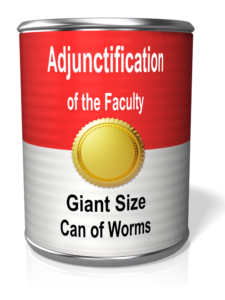
Really, I didn’t plan this! When, I saw that the first topic of my series of problems in American higher education turned out to be the “Adjunctification of the Faculty“, I knew it going to be complicated and involved. It wasn’t until I started writing this post did I realized how really complicated and involved it was, and how difficult it was going to be to write this post. It has turned out to be a gigantic can of worms.

Where does one begin? In mathematics, we were taught that there were two places to begin to address a problem. The first was to find what others had done and written concerning the problem. In terms of the idea of adjunctification of the faculty, I found the first usage of the term only dated back to the 1980s. However, since its introduction to educational jargonese, much has been written about it. I had a great deal of reading and study to do on the subject.

Returning to my mathematical roots, the second place to begin trying to address problems was to define our terms. To understand the concept of “adjunctification of the faculty” let’s start with a definition. Since the term “adjunctification” is a very recent addition to educational jargon, I didn’t find one dictionary which included it.
Thus, we should probably start by looking at the definition of adjunct, the root word of adjunctification. The term adjunct has been used in the English language since the 16th century. It is derived from the Latin word adiungō, which means to “to join”.

In many dictionaries, the word adjunct means “something adjoined or added to the essentials, usually as a supplement or subordinate.” In common usage, it often carries the dismissive or disparaging connotation of something that is less important or not essential.
If we were to rely on this common dictionary definition, an adjunct faculty member is someone who is added to the teaching staff of a college in a temporary or subordinate capacity. Unfortunately, as is often the case, higher education experts have added extra terminology to the discussion, which only confuses the matter more. One such term is contingent faculty.

The word contingent is also a word which is loaded with negative connotations. One of its primary meanings is “occurring only if certain unpredictable conditions exist.” One of the premier higher educational organization, The American Association of University Professors (AAUP), has stepped forward and planted its flag on the following definition of contingent faculty: “non-tenure track faculty, in all their various forms.”

Since its founding in 1915, The AAUP has laid claim to the role of the standard bearer for academic freedom, shared governance, and quality in American higher education. In its mission statement, it sets itself up as the primary organizations which defines the fundamental professional values and standards of higher education, in order to ensure higher education’s contribution to the common good.

In its mission statement, it also puts on a labor union hat. It asserts its duty and responsibility to the job of promoting the economic security of faculty, academic professionals, graduate students, post‐doctoral fellows, and all those engaged in teaching and research in higher education.
There are two bodies of research. The first establishes the fact that many part-time faculty are conscientious and are excellent instructors. The second establishes the fact that for some students alternative modes of instruction such as online education can be as, if not more, effective than the face-to-face mode.

Much of this research is discounted or ignored by higher education commentators. Most of the articles on contingent faculty are written from the presumptive position that the best education is provided by full-time, tenure-track faculty in a face-to-face setting.
Given this starting position, it is natural to argue that it is in the best interest of everyone to increase the number of full-time, tenure track faculty and the availability of face-to-face contact between students and these full-time, tenure track faculty. Even if this statement is true, that does not prove or guarantee that its inverse is true. Thus we can’t assume that decreasing the number of contingent faculty and eliminating alternative modes of education will provide the best education possible for all students.
The collection of educational data in the United States has a spotted history. One of the few specific responsibilities given the federal Department of Education at its founding in 1867 was the collection of annual higher education statistics related to the number of approved colleges or universities offering degrees, along with the total number of enrolled students, graduates, and faculty. Prior to WWII, there were few organized attempts to count or track the number of faculty members employed by American institutions of higher education by classification. Since the end of WWII, the AAUP has been at the forefront of the effort to count and classify instructional staff at American institutions of higher education. More recently the U.S. Department of Education has reentered the fray with its annual surveys associated with the Integrated Postsecondary Education Data System (IPEDS) and the National Center for Educational Statistics (NCES). The federal efforts are now coordinated through the efforts of the Institute of Education Sciences (IES), the statistical, research and evaluation arm of the U.S. Department of Education.

Since the late 1960s, the AAUP has been tracking and decrying the increasing reliance on contingent faculty in American higher education. For example, the AAUP released a copy of the graph to the right, representing the changes in the headcount of tenure-line (full-time tenured and tenure track faculty) and contingent faculty (all other instructors).
Although I am convinced the information presented in the graph is accurate, it is potentially none the less extremely misleading. A quick glance at the graph could leave one to believe that in 2015, only 30% of the classes taken by American college students were being taught by tenured or tenure-track faculty, while 70% were being taught by contingent faculty.
First of all, we don’t have that data. No one is collecting the data nationally on who is teaching whom. In the early 1980s, I was collecting that data for one particular college. That college was a small, baccalaureate-level, liberal arts college with no graduate programs. It offered tenure to faculty with the rank of Assistant Professor or above. Using AAUP definitions, of the 103 individuals who taught classes, 46% were tenure-line and 54% were contingent.
With this data, one might be tempted to say that it was more likely for a student to be taught by a contingent faculty than one on the tenure-line. There is more to the picture. As a baccalaureate-level, liberal arts college, the faculty’s primary responsibility was instruction. For full-time faculty, the minimum teaching load was 12 credits per semester. Since course sections carried anywhere from 0 to 4 credits per sections, the average section load for tenure-line faculty was 4.3 sections per semester. Since there were only 4 full-time instructors who were not on the tenure-line, the average number of sections taught by contingent faculty was 1.5 sections per semester.
In addition to the fact that the average number of sections taught by faculty were heavily weighted toward the tenure-line faculty, the average enrollment per section was heavily weighted toward them also. It was also the case that the tenure-line faculty were more likely to teach the 3 and 4 credit sections, while the contingent faculty taught more of the 0 (science labs) to 2 credit sections.

The graph to the left indicates the percentage differences between tenure-line and contingent faculty, if we were to look at faculty headcount, the number of sections taught, student section enrollments, and student credits generated. This graph paints a very different picture of how likely a student would end up with a tenure-line faculty versus a contingent faculty, even in a college where the contingent faculty outnumber the tenure-line faculty.
The AAUP as a faculty organization explicitly approaches situations from the faculty point of view. That point of view generally presupposes that a full-time, tenure-line faculty member is better than a contingent faculty member. One of the reasons given by an advertisement from the 1960 AAUP Bulletin for why faculty should join and support the AAUP indicates that the organization…”Tries to find common ground with administrators and trustees, for the establishment and observance of professional principles.”
Those professional principles were established from the faculty point of view. In my experience, this has meant that an institution’s first step should be to hire full-time, tenure-track faculty. For an institution that is operating a department of music, and not a conservatory, this is fiscally impossible and makes no sense for the institution. In this case, the AAUP response is to pay a private lesson instructor or ensemble conductor at the equivalent rate to a full-time, tenure-track individual doing that same duty. The absurdity of this idea is obvious when one tries to calculate equivalencies.
A full-time, tenure-track faculty member is doing much more than just giving private lessons. He or she should be involved in scholarly and service activities. The AAUP response is to involve the contingent faculty in equivalent scholarly and service activities. Firstly, most private lesson instructors are doing this as a side gig and can’t find the time to engage in such activities.
Secondly, an institution couldn’t afford to hire full-time faculty for each instrument that students might desire to learn. A small to medium sized music department would be fortunate to have one or two student harpists. The harp is such a specialized instrument that a school would also have to be fortunate to find a harp instructor, who could also handle other string instruments. A good music student would want and seek out an institution that has an excellent specialist in his or her instrument.
Thirdly, in terms of equivalent service, particularly to the department, it has been my experience that the “regular full-time faculty” do not want “outsiders interfering with departmental business.”
Similar situations occur in other disciplines such as art, theater, physical education, and health sciences.
One final concern in looking at everything from the faculty point of view is that it is easy to lose track of the students’ points of view. In forty plus years of experience in attempting to schedule classes to fit the needs of faculty and students, I have seen many impasses. At one institution where I served, the student body was almost 60% commuters and more than 25% were working more than 20 hours per week. The full-time, tenure-track faculty was similar in makeup to the faculty from the example presented above. The students kept asking for evening classes to accommodate their personal and family situations. However, the full-time faculty refused and insisted on offering classes only between the hours of 8 AM and 4 PM. Needless to say, this institution had a serious retention problem. As word spread in the community of the inability of students to get classes when they wanted them, it also turned into a serious student recruitment problem.
There is no doubt that faculty are a necessity to the success of a college. However, for most colleges students are even more of a necessity. With the exception of a few elite colleges, the concerns of both groups must be carefully balanced.
This has been a difficult and gut-wrenching post to write. I couldn’t have planned it worse if I tried. The next higher education trainwreck post on my schedule is on Faculty Rewards and Priorities. I need a short break from these difficult topics, so I am going to take a week’s reprise from tackling that subject. My next post will return to an easier subject for me. It will be about the crazy mathematician Archimedes.